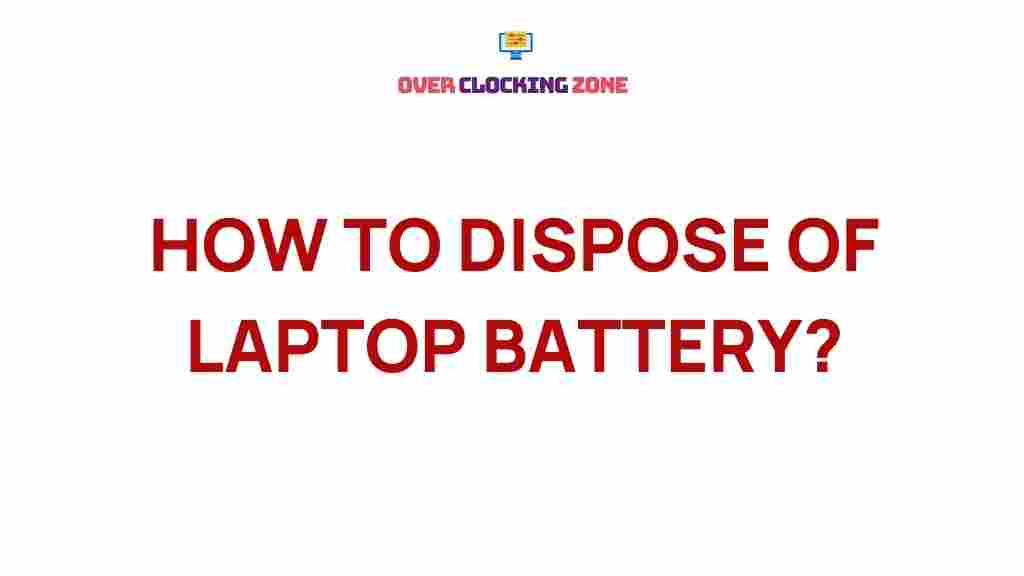Understanding the Importance of Proper Laptop Battery Disposal
Disposing of a laptop battery might seem straightforward, but improper disposal can have significant environmental and safety implications. With millions of laptops being replaced annually, the accumulation of discarded batteries poses risks like toxic chemical leakage and fires. In this guide, we uncover the secrets to handling your laptop battery responsibly.
What Happens When a Laptop Battery Is Disposed of Improperly?
Before diving into the right practices, it’s crucial to understand the potential damage of neglect. Improperly discarded laptop batteries can:
- Release harmful chemicals like lead, cadmium, and mercury into the soil and water.
- Increase the risk of landfill fires due to battery punctures or short circuits.
- Contribute to the growing issue of e-waste pollution.
These concerns highlight the necessity of learning the correct disposal methods.
How to Properly Dispose of Your Laptop Battery
Step 1: Determine the Battery Type
The first step is identifying the type of laptop battery you have. Common types include lithium-ion (Li-ion), nickel-metal hydride (NiMH), and nickel-cadmium (NiCd) batteries. Each type has unique handling and recycling protocols. Check the battery label or consult your laptop’s manual for details.
Step 2: Prepare the Battery for Disposal
Before disposing of the battery:
- Ensure it’s fully discharged: This reduces the risk of accidental fires or chemical leaks.
- Insulate the terminals: Use electrical or duct tape to cover the terminals and prevent short circuits.
Step 3: Find an Authorized Recycling Facility
Locate a certified e-waste recycler or drop-off point in your area. Many municipalities have dedicated programs for battery recycling. Additionally, manufacturers and retailers like Best Buy or Staples often accept used laptop batteries for safe disposal.
Use resources like Call2Recycle to find a nearby recycling facility.
Step 4: Hand Over the Battery
Bring the prepared battery to the facility or retailer. If mailing the battery, ensure it complies with shipping regulations for hazardous materials.
Best Practices for Extending Laptop Battery Life
Reducing the frequency of replacement is a sustainable approach to handling your laptop battery. Follow these tips to extend its lifespan:
- Avoid overcharging by unplugging the charger once the battery reaches 100%.
- Keep the battery between 20%-80% charge for optimal health.
- Store the battery in a cool, dry place if unused for extended periods.
For more insights on laptop care, visit our maintenance guide.
Troubleshooting Common Battery Disposal Issues
What if I Can’t Find a Recycling Center Nearby?
If local options are unavailable, check if your laptop’s manufacturer offers a mail-in program. Brands like Dell and HP provide free battery recycling services.
What Should I Do with a Swollen Battery?
Swollen batteries require special handling due to their volatile nature. Do not attempt to puncture or compress the battery. Instead:
- Place it in a non-conductive container.
- Bring it directly to a hazardous waste facility.
Can I Throw Laptop Batteries in the Trash?
Absolutely not. Discarding batteries in the regular trash can lead to environmental contamination and safety hazards. Always opt for recycling.
Conclusion
Proper disposal of a laptop battery is not just an ethical responsibility but also a legal and environmental necessity. By following the steps outlined above, you can contribute to a safer, greener planet. Remember, small efforts like recycling a single laptop battery can have a profound impact on reducing e-waste pollution.
Make the conscious choice to dispose of your batteries responsibly and share this guide with others to spread awareness.
This article is in the category Guides & Tutorials and created by OverClocking Team
